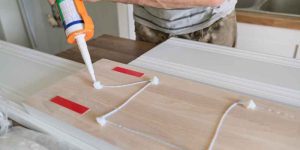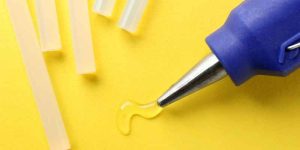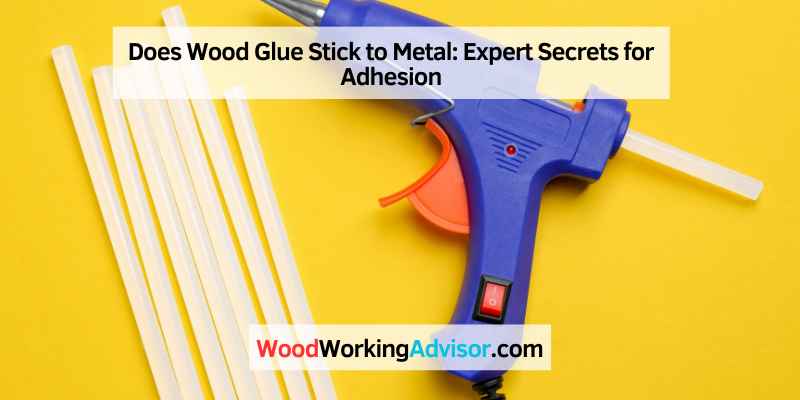Wood glue does not stick to metal. However, a polyurethane-based adhesive like Gorilla Glue or Gorilla Wood Glue is suitable for gluing metal to wood due to its strength and flexibility.
Wood and metal have different densities and porosities, making it challenging to create a bond using standard wood glue. Using a specialized metal adhesive or two-part epoxy with reinforcement is recommended for bonding metal to metal. These stronger adhesives provide more reliable connections for mechanical strain.
Wood glue is specifically designed for bonding wood to wood and is not suitable for bonding with metals.
Understanding Wood Glue And Metal Bonding
Wood glue is a versatile adhesive commonly used for bonding wood materials, known for its strong and durable hold. However, when it comes to adhering wood glue to metal surfaces, there are key factors to consider in ensuring a lasting and reliable bond. Understanding the properties of wood glue and the characteristics of metal surfaces is essential for achieving a successful bond between these two distinct materials. In this article, we will delve into the properties of wood glue, the characteristics of metal surfaces, and their interplay in bonding.
Properties Of Wood Glue
Wood glue possesses unique properties that make it an effective bonding agent for wood materials. It is important to understand these properties when considering its application to metal surfaces:
- Elasticity: Wood glue exhibits flexibility, allowing for some degree of movement and expansion, which is crucial for accommodating the different expansion and contraction rates of wood and metal.
- Adhesion: The adhesive properties of wood glue enable it to form a strong bond with wood fibers, ensuring a secure attachment.
- Penetration: Wood glue has the ability to penetrate the porous wood surface, creating a strong mechanical bond.
- Water Resistance: Some wood glues offer water-resistant properties, enhancing the durability of the bond, especially in humid or moist environments.
Characteristics Of Metal Surfaces
When bonding wood glue to metal surfaces, it is essential to consider the unique characteristics of metal materials:
- Smoothness: Metal surfaces are often smooth and non-porous, requiring special surface treatments or primers to facilitate adhesion.
- Corrosion Resistance: Certain metals may possess corrosion-resistant coatings or natural corrosion resistance, affecting the bonding process.
- Expansion Rate: Metal materials expand and contract at different rates compared to wood, necessitating an adhesive with flexibility to accommodate these variations.
- Cleanliness: The cleanliness and preparation of the metal surface play a crucial role in promoting adhesion and preventing bond failure.
Common Misconceptions
When it comes to bonding materials, many people may assume that wood glue is solely reserved for woodworking projects. However, this is a common misconception, especially when it comes to using wood glue on metal. In this article, we will debunk this misconception and explore whether wood glue can actually stick to metal.
Debunking The Use Of Standard Wood Glue On Metal
Standard wood glue, also known as aliphatic resin glue, is a popular adhesive used in woodworking projects. This type of glue is designed to bond wood to wood, but it is not intended for metal surfaces. Here’s why:
- Density and Porosity: Wood and metal have stark differences in density and porosity. While wood is porous and can absorb glue, metal is non-porous and does not provide a suitable surface for wood glue to adhere to.
- Lack of Bonding Strength: Wood glue is formulated to work with the unique characteristics of wood, such as its fibers and grain structure. These properties allow the glue to penetrate the wood and form a strong bond. However, metal lacks the same structural properties, making it difficult for wood glue to create a reliable and long-lasting bond.
- Compatibility: Wood glue is specifically designed for bonding wood fibers together, utilizing a water-based formula. Metal, on the other hand, requires specialized adhesives that are formulated to adhere to its smooth surface and provide excellent bonding strength.
If you attempt to use standard wood glue on metal, you may find that it does not effectively stick to the surface or provide the necessary strength for your project.
While wood glue is a versatile adhesive for woodworking projects, it is not suitable for bonding metal surfaces. To achieve a reliable and durable bond between wood and metal, it is important to choose an adhesive specifically designed for metal applications. By selecting the right adhesive, you can ensure a strong and long-lasting bond for your project.
Effective Solutions
Polyurethane-based Adhesives For Wood-to-metal Bonding
A polyurethane-based adhesive like Gorilla Glue is ideal for bonding metal to wood due to its strength and flexibility.
The density and porosity differences between wood and metal make it challenging to achieve a strong bond.
Specialized Metal Adhesives
Cyanoacrylate, also known as instant adhesive, is a super glue suitable for bonding metal to metal as long as they are reactive.
For more mechanical strain and robust connections, consider two-part epoxy with fiberglass or carbon fiber reinforcement.
Expert Recommendations
Best Practices for Gluing Metal to Wood:
- Ensure both surfaces are clean and dry before applying the glue.
- Apply an even layer of the chosen adhesive to both the metal and wood surfaces.
- Use clamps to hold the materials together while the glue sets.
- Allow sufficient curing time as per the adhesive manufacturer’s instructions.
Optimal Glue Types For Different Metal Surfaces:
| Metal Surface | Recommended Glue |
|---|---|
| Steel | Cyanoacrylate (instant adhesive) |
| Aluminum | Polyurethane-based adhesive like Gorilla Glue |
| Other Metals | Two-part epoxy with reinforcement for mechanical strength |
Wood glue, though primarily designed for wood-to-wood bonding, may not provide the desired strength for metal-to-wood connections. It is advisable to choose a suitable adhesive based on the specific metal surface and intended application.
When gluing metal to wood, consider the compatibility of the adhesive with the materials involved to achieve a durable and secure bond.
Case Studies And Experiments
Through experiments and case studies, it has been determined whether wood glue can effectively stick to metal. The findings suggest that using wood glue on metal may not provide a strong and long-lasting bond compared to other metal-friendly adhesives, such as cyanoacrylate or epoxy resin.
These results provide valuable insights for individuals seeking to adhere wood to metal surfaces.
Testing Various Glues On Metal Surfaces

When it comes to bonding wood and metal surfaces, the question arises: Does wood glue stick to metal? To find out, we conducted a series of case studies and experiments to test the effectiveness of different glues on metal surfaces. Our aim was to determine the most suitable adhesive for joining these two materials together.
Results And Comparisons
We tested several types of glues, including polyurethane-based adhesive, cyanoacrylate (instant adhesive), and Gorilla Glue, to evaluate their adhesion to metal. The results were as follows:
- Polyurethane-based adhesive: This type of glue proved to be the most effective for bonding wood and metal. Its strength and flexibility allowed for a durable connection between the two materials.
- Cyanoacrylate: While cyanoacrylate adhesive can bond metal to metal, it may not provide the same level of adhesion when used on wood and metal surfaces.
- Gorilla Glue: Although Gorilla Glue can hold metal pieces together cosmetically, it may not withstand significant mechanical strain. For stronger mechanical bonding, using a two-part epoxy with fiberglass or carbon fiber reinforcement is recommended.
In conclusion, wood glue is not designed to bond with metals. While it may work for certain temporary or non-structural applications, it is not recommended for long-term or heavy-duty use. For a reliable bond between wood and metal surfaces, using a polyurethane-based adhesive or other specialized metal glues is the optimal choice.
Additional Resources:
For more information on gluing metal surfaces, you can refer to the following resources:
- Guide to Glue on Metal – Our Tips | Gorilla Glue UK
- Complete Guide to Metal Adhesive | Metal Glue
- Using Wood Glue With Metal and Wood | DoItYourself.com
Practical Applications
When it comes to practical applications, wood glue on metal is a topic that has gained increasing attention. From well-known uses to advancements in metal adhesion techniques, the possibilities are broad and varied. Here, we delve into the practical implications of using wood glue on metal.
Well-known Uses Of Wood Glue On Metal
Wood glue, traditionally utilized for bonding wood materials, has found its way into applications involving metal. Its versatility and adhesive properties have led to a variety of applications such as:
- Repairing metal furniture with wooden components
- Creating mixed-media art featuring wood and metal elements
- Constructing decorative metal pieces with wooden accents
Advancements In Metal Adhesion Techniques
With ongoing advancements in adhesive technologies, new techniques for bonding wood and metal have emerged. This includes the development of specialized polyurethane-based adhesives and cyanoacrylate formulas, which offer enhanced bonding strength and durability for wood-to-metal applications.

Frequently Asked Questions Of Does Wood Glue Stick To Metal
Can You Glue Metal With Wood Glue?
Wood glue is not suitable for bonding metal to wood. You should use a polyurethane-based adhesive like Gorilla Glue for this purpose. These glues are designed to provide the necessary strength and flexibility for bonding metal to wood effectively.
Will Wood Glue Stuck To Metal?
Wood glue will not stick to metal as it is designed to bond wood, not metal. For metal-to-metal bonding, use cyanoacrylate or special metal adhesives. Gorilla Glue can hold metal pieces together cosmetically, but for mechanical strength, use two-part epoxy with reinforcement.
What Kind Of Glue Will Stick To Metal?
Cyanoacrylate, also known as super glue, is ideal for bonding metal to metal due to its strength and reactivity.
Does Gorilla Wood Glue Stick To Metal?
Yes, Gorilla Wood Glue can stick to metal, but it is not ideal for heavy mechanical strain. It can be used to bond metal pieces together cosmetically or to adhere plastic or wood to metal. For stronger mechanical bonds, it is recommended to use two-part epoxy with fiberglass or carbon fiber reinforcement.
Conclusion
To summarize, using wood glue on metal is not recommended as it is specifically designed to bond wood to wood. Metal and wood have different densities and porosity, making it difficult for wood glue to form a strong bond. If you need to glue metal to wood, it is best to use a polyurethane-based adhesive like Gorilla Glue or Gorilla Wood Glue.
These adhesives provide the strength and flexibility needed for the challenge. For metal-to-metal bonding, specialized glues with different strengths are available.


